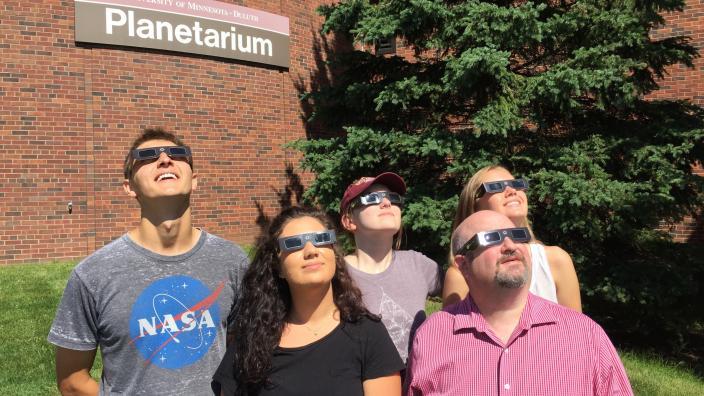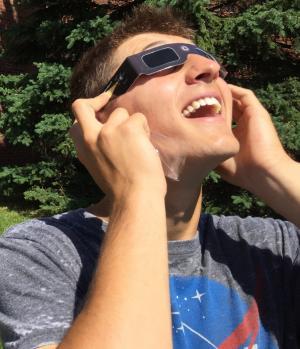From Oregon to South Carolina, dusk will suddenly settle in the middle of the day. Crickets will start chirping, birds will stop singing, even the temperature will plummet. It all happens on August 21, when a solar eclipse will be visible throughout the entire lower 48 states. Hundreds, possibly thousands, of UMD students, faculty, staff and alumni will travel to the path of totality for the solar eclipse. The path will cross the U.S. in about two hours at 700 miles an hour.
Josh Wasniewski, UMD senior, physics major and astronomy minor, is an insatiable stargazer. “The more I learn about a total eclipse, the more I want to see this one,” he says. As program coordinator for the Marshall W. Alworth Planetarium, Josh is especially interested in experiencing the eclipse firsthand.
He is determined to travel over 1,000 miles to get to Idaho Falls. Idaho is one of the best locations for eclipse viewing because of the clear August weather and prime mountaintop viewing sites. “I’m either driving out to Idaho Falls or flying out,” he says. "I'm going to get there."
WHAT AND WHERE
People watching in the path of totality, a 70 mile wide route that crosses the United States, will see a total solar eclipse as the new moon covers the sun for around two minutes at each site.
“People who want the best experience should to get to the path of totality,” says Dr. Marc Seigar, UMD’s associate dean of the Swenson College of Science and Engineering (SCSE).
In this path, viewers will be able to see unique phenomena, including the sun’s corona, Baily’s beads, and diamond rings.
“The corona is the outermost layer of the sun,” says Josh. “They call it ethereal looking; it looks wispy. Then, when the moon moves in front of the sun, you see Baily’s beads, round shapes made by little rays of light peeking through the peaks and the valleys on the moon,” says Josh.
He explains the diamond ring effect, an illusion of a ring of brightness which occurs along with Baily’s beads, just before and after the moon completely eclipses the sun.
And then there are the strange patterns made when the tiny gaps between leaves act as pinhole lenses, “If you look down while it’s happening, you can see mini solar eclipses all over the ground,” Josh says.
UMD EVENTS
If you can’t travel, you will still get a show. For the first time in 40 years, everyone in the lower 48 states will be able to see the moon cover at least 80 percent of the sun.
On Saturday nights at 7 pm, during the month of August, the Marshall W. Alworth Planetarium will present, “Totality,” a 25-minute full dome show that explains what a solar eclipse is, and how and when they occur.
ONE SPECIAL DAY
On August 21, UMD will set up its portable GeoDome at The Sports Garden in Duluth’s Canal Park, where they will show “Totality,” before and after the eclipse. A live feed from NASA will be broadcast on televisions throughout the restaurant.
During the partial eclipse just after 1 pm, UMD will set up a telescope and pass out solar eclipse protective glasses outside The Sports Garden on the harbor side. UMD staff and volunteers will also be on hand to answer questions. Grandma's will offer food and drink specials. UMD thanks Grandma's Restaurants for their support presenting this once-in-a-lifetime event.
Keep in mind, people can permanently damage their eyes by looking at the sun, so using protective glasses is important.
Join the fun, check out #UMDeclipse2017 on Twitter and Facebook.
Photo above (l-r) UMD students Josh Wasniewski, Caitlyn Tanner, Samantha Church, and (far right) Krystyna Bobel. Marc Seigar, SCSE associate dean, is second from the right.

